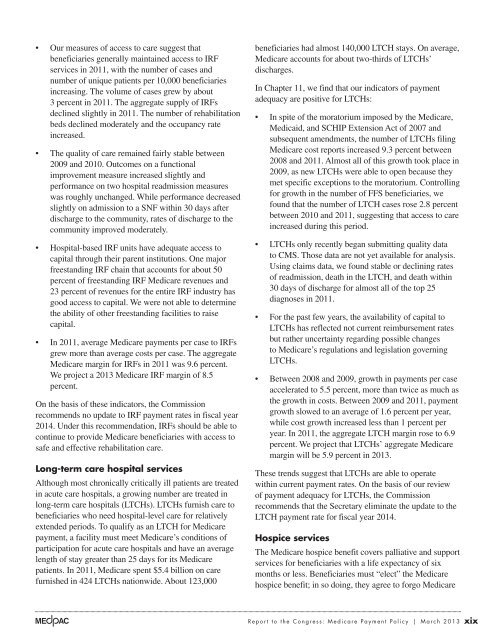Medicare Payment Policy
Medicare Payment Policy
Medicare Payment Policy
You also want an ePaper? Increase the reach of your titles
YUMPU automatically turns print PDFs into web optimized ePapers that Google loves.
• Our measures of access to care suggest that<br />
beneficiaries generally maintained access to IRF<br />
services in 2011, with the number of cases and<br />
number of unique patients per 10,000 beneficiaries<br />
increasing. The volume of cases grew by about<br />
3 percent in 2011. The aggregate supply of IRFs<br />
declined slightly in 2011. The number of rehabilitation<br />
beds declined moderately and the occupancy rate<br />
increased.<br />
• The quality of care remained fairly stable between<br />
2009 and 2010. Outcomes on a functional<br />
improvement measure increased slightly and<br />
performance on two hospital readmission measures<br />
was roughly unchanged. While performance decreased<br />
slightly on admission to a SNF within 30 days after<br />
discharge to the community, rates of discharge to the<br />
community improved moderately.<br />
• Hospital-based IRF units have adequate access to<br />
capital through their parent institutions. One major<br />
freestanding IRF chain that accounts for about 50<br />
percent of freestanding IRF <strong>Medicare</strong> revenues and<br />
23 percent of revenues for the entire IRF industry has<br />
good access to capital. We were not able to determine<br />
the ability of other freestanding facilities to raise<br />
capital.<br />
• In 2011, average <strong>Medicare</strong> payments per case to IRFs<br />
grew more than average costs per case. The aggregate<br />
<strong>Medicare</strong> margin for IRFs in 2011 was 9.6 percent.<br />
We project a 2013 <strong>Medicare</strong> IRF margin of 8.5<br />
percent.<br />
On the basis of these indicators, the Commission<br />
recommends no update to IRF payment rates in fiscal year<br />
2014. Under this recommendation, IRFs should be able to<br />
continue to provide <strong>Medicare</strong> beneficiaries with access to<br />
safe and effective rehabilitation care.<br />
Long-term care hospital services<br />
Although most chronically critically ill patients are treated<br />
in acute care hospitals, a growing number are treated in<br />
long-term care hospitals (LTCHs). LTCHs furnish care to<br />
beneficiaries who need hospital-level care for relatively<br />
extended periods. To qualify as an LTCH for <strong>Medicare</strong><br />
payment, a facility must meet <strong>Medicare</strong>’s conditions of<br />
participation for acute care hospitals and have an average<br />
length of stay greater than 25 days for its <strong>Medicare</strong><br />
patients. In 2011, <strong>Medicare</strong> spent $5.4 billion on care<br />
furnished in 424 LTCHs nationwide. About 123,000<br />
beneficiaries had almost 140,000 LTCH stays. On average,<br />
<strong>Medicare</strong> accounts for about two-thirds of LTCHs’<br />
discharges.<br />
In Chapter 11, we find that our indicators of payment<br />
adequacy are positive for LTCHs:<br />
• In spite of the moratorium imposed by the <strong>Medicare</strong>,<br />
Medicaid, and SCHIP Extension Act of 2007 and<br />
subsequent amendments, the number of LTCHs filing<br />
<strong>Medicare</strong> cost reports increased 9.3 percent between<br />
2008 and 2011. Almost all of this growth took place in<br />
2009, as new LTCHs were able to open because they<br />
met specific exceptions to the moratorium. Controlling<br />
for growth in the number of FFS beneficiaries, we<br />
found that the number of LTCH cases rose 2.8 percent<br />
between 2010 and 2011, suggesting that access to care<br />
increased during this period.<br />
• LTCHs only recently began submitting quality data<br />
to CMS. Those data are not yet available for analysis.<br />
Using claims data, we found stable or declining rates<br />
of readmission, death in the LTCH, and death within<br />
30 days of discharge for almost all of the top 25<br />
diagnoses in 2011.<br />
• For the past few years, the availability of capital to<br />
LTCHs has reflected not current reimbursement rates<br />
but rather uncertainty regarding possible changes<br />
to <strong>Medicare</strong>’s regulations and legislation governing<br />
LTCHs.<br />
• Between 2008 and 2009, growth in payments per case<br />
accelerated to 5.5 percent, more than twice as much as<br />
the growth in costs. Between 2009 and 2011, payment<br />
growth slowed to an average of 1.6 percent per year,<br />
while cost growth increased less than 1 percent per<br />
year. In 2011, the aggregate LTCH margin rose to 6.9<br />
percent. We project that LTCHs’ aggregate <strong>Medicare</strong><br />
margin will be 5.9 percent in 2013.<br />
These trends suggest that LTCHs are able to operate<br />
within current payment rates. On the basis of our review<br />
of payment adequacy for LTCHs, the Commission<br />
recommends that the Secretary eliminate the update to the<br />
LTCH payment rate for fiscal year 2014.<br />
Hospice services<br />
The <strong>Medicare</strong> hospice benefit covers palliative and support<br />
services for beneficiaries with a life expectancy of six<br />
months or less. Beneficiaries must “elect” the <strong>Medicare</strong><br />
hospice benefit; in so doing, they agree to forgo <strong>Medicare</strong><br />
Report to the Congress: <strong>Medicare</strong> <strong>Payment</strong> <strong>Policy</strong> | March 2013<br />
xix


